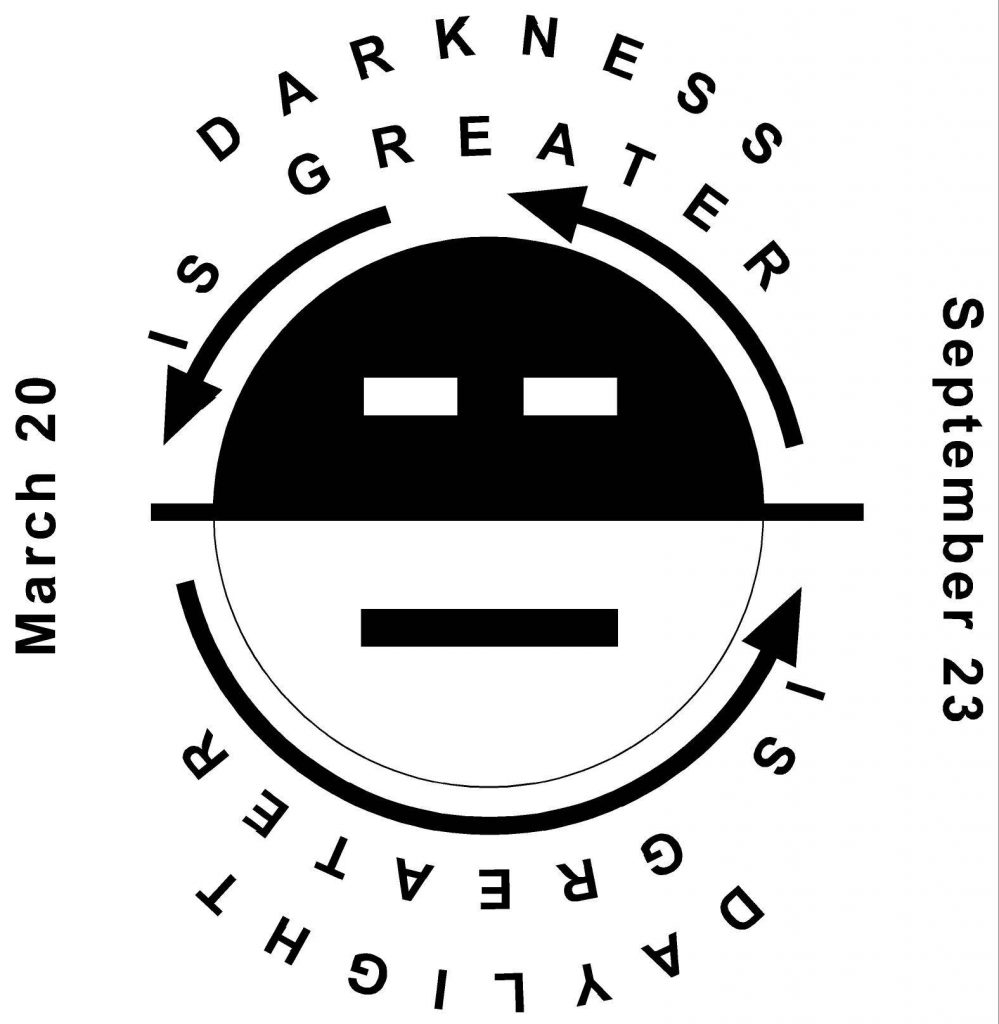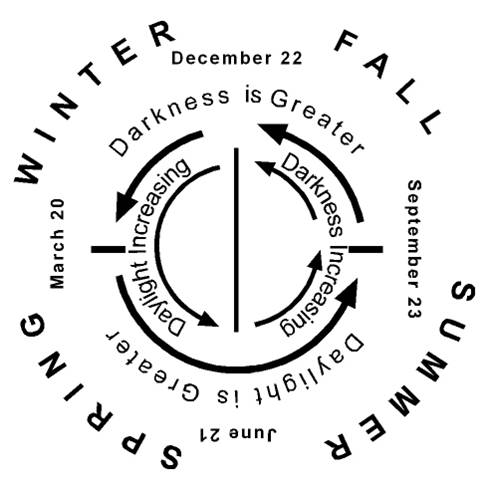Foundations of the Zodiac

Half of the year daylight increases, from December 22 to June 21. From the winter solstice to the summer solstice, or from the greatest darkness to the greatest light, the amount of daylight in each day increases.
The other half of the year darkness increases, from June 21 to December 22. From the summer solstice to the winter solstice, or from the greatest light (longest day) to the greatest darkness (longest night), the amount of darkness in each day increases.

This diagram shows the duality as the previous, that of the light increasing and darkness increasing halves of the year. Also shown on this diagram is the solid line correspondence to the daylight increasing phase and the broken line correspondence to the darkness increasing phase.
The two dates show the two extremes. In every cycle there are two extremes, and from this the other changes can be determined.
June 21 is the longest day, and December 22 is the longest night.
After the greatest darkness, light increases. After the greatest brightness, darkness increases.

Half of the year there is more daylight than darkness. This is the half starting from March 20 and lasting until September 23.
Half of the year there is more darkness than daylight. This is the half starting from September 23 and lasting until March 20.
This is the second great division of the year. This is not theory, but experiential observation. This is the actual phenomena of the light in the cycle of a year.

Once one observes the two extreme, one can then observe the midpoints between the two extremes.
Here we see that the daylight greater half of the year is assigned the solid line, and the darkness greater half of the year is assigned the broken line.

In this drawing we can see the two cycles together in the same drawing. With it we can see the four main turning points in the year: December 22, March 20, June 21, and September 23.
On the inner circle we can see the daylight increasing and darkness increasing halves of the year.
On the outer circle we can see the daylight is greater and the darkness is greater halves of the year.

When we consider these two primary distinctions we can observe the four phases of the year with a clear perspective.
In Winter, December 22 to March 20, daylight is increasing but there is still more darkness than daylight, hence it is dark and cold (but getting brighter).
In Spring, March 20 to June 21, daylight is increasing and there is more daylight each day than there is darkness, hence it is light and hot (and getting brighter).
In Summer, June 21 to September 23, there is more daylight than darkness, but the days are getting shorter and the nights are getting longer….. darkness is increasing.
In the Fall, September 23 to December 22, there is more darkness than daylight and the days are
continuing to get shorter and the nights are getting longer……… darkness is increasing.

Here we see the same four seasons with the solid and broken lines in their appropriate positions. On the inner most circle the solid line represents the increasing daylight, and the broken line represents the increasing darkness. On the outer cycle th solid line represents the half when daylight is greater, and the broken line represents the half when darkness is greater.
(This drawing is valid for the northern hemisphere. In the southern hemisphere the seasons are reversed as are the times when daylight and darkness are increasing or decreasing, greater or lesser. In the southern hemisphere this cycle is reversed)
This gives us a definition for each season or quarter of the year.
Daylight increasing and darkness greater defines the phase of winter.
Daylight increasing and daylight greater defines spring.
Darkness increasing and daylight greater defines the phase of summer.
Darkness increasing and darkness greater defines fall.

Here we see the four seasons and the lines of change without the words, but one can now understand what it is saying. It is providing the proper perspective for understanding the cycle of the year. This cycle is the same as the cycle of the zodiac, and it sets the primary consideration for understanding the zodiac signs.
The greater the light, the greater the activity. The greater the activity the greater the sense of freedom and creativity. The greater the darkness, the more difficult it becomes to be active. With this increase in difficulty or the subsequent decrease in activity, comes an increased sense of responsibility and concern. This is the essence of the broken line of receptivity and darkness

The next distinction is the midpoint of each season. This divides each season into two phases. The result is a third circle of distinction in which there are eight divisions or phases.
In the I Ching it is said the four bigrams or two line figures divide and take on a solid and a broken line to clarify the distinction, and we now have a cycle of eight trigrams.
This can be understood in the terms of the year, and its light and dark implications. There is now a light and a dark half for each season.

In this diagram the light and dark halves of each season are labeled. You can see that the outermost line will be broken for the dark half of each season and solid for the light half of each season.
There are eight possible combinations of solid and broken lines in a three line trigram. These are the eight trigrams in their correct sequence as applied to the year.
In this sequence the trigrams are positioned by observation of phenomena, not by theory. The sequence is of course the original sequence of Fu Hsi.

In this drawing the signs of the zodiac are added to the circle. The zodiac signs also elaborate the seasons and the circle of the year. The forty-five degree divisions of the I Ching can be seen against the thirty degree divisions of the zodiac signs. The midpoint of each season corresponds to the midpoint of the fixed zodiac signs of Taurus, Leo, Scorpio, and Aquarius.
(If you are not familiar with the symbols for the zodiac signs, they will be written out two drawings ahead.
(Again, it should be remembered that the seasons and signs are opposite in the southern hemisphere, starting at the opposite times of the year.)

The four seasonal midpoints have long been associated with Wiccan traditions and ceremonies and are celebrated accordingly. The names of these holidays have been put on the circle.
Because of calendrical differences there are debates about what day to celebrate these holidays on. From this drawing, it becomes obvious that it would be at the exact midpoint of each season.
